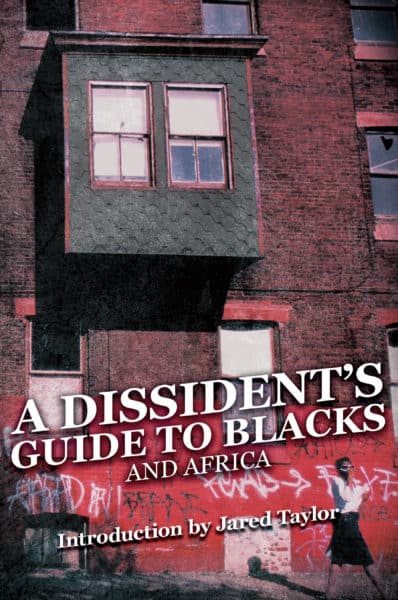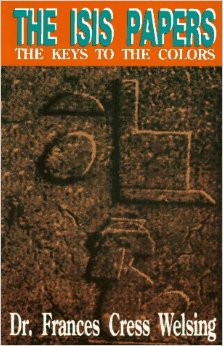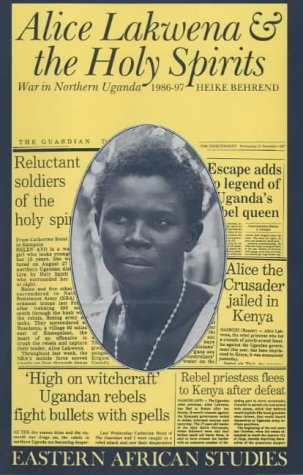Can Blacks and Whites Live Together?
John Jackson, American Renaissance, September 30, 2020
Jared Taylor, editor, A Dissident’s Guide to Blacks and Africa, New Century Books, 2020, 220 pp., $24.95.
The articles in A Dissident’s Guide to Blacks and Africa have all appeared in American Renaissance, so as a regular reader, I was afraid I would have already seen them all. I was pleasantly surprised. The two dozen articles were published over a period of more than ten years, so even fanatical fans of AmRen are likely to find a lot that is new. This is an interesting mix of book reviews, essays, and personal accounts about blacks, both in the United States and Africa. Here are some that were highlights for me.

Jared Taylor’s February 2015 essay “What I Like About Blacks” is about the spontaneous, uninhibited nature of blacks. He quotes a half-Asian friend who says that white men act like Asians who have had a few drinks, and blacks act like whites after a few drinks. Spontaneity is surely part of black success in jazz and comedy, both of which often involve improvisation but, as Mr. Taylor notes, it can lead to crime.
As if to even things out, American Renaissance followed this article with a reply by a black woman who used the name Zora Wheatley. In “What I Don’t Like About Blacks,” she criticizes her own people for the crude eroticism of both sexes, and for black women’s custom of beating children.
Miss Wheatly notes that we are now supposed to think it is unbearable to hear that anyone is less able than anyone else, so that the merest hints of inferiority condemn blacks to ignorance and crime. But she writes that most white people easily recognize that others outdo them in some respects. Theories of “racism” so popular among blacks are a way to explain away their own failures as caused by forces beyond their control.
Several interesting essays are about bizarre beliefs blacks hold. A review of The Isis Papers by black psychiatrist and academic Frances Cress Welsing reports her conviction that whites constantly abuse and try to dominate blacks because they feel inferior to them. Whites are “genetic mutant defectives” with recessive traits, and are afraid of miscegenation because it will lead to “genetic annihilation.”

Dr. Welsing, who died in 2016, claimed that whites are obsessed with black sexuality, especially with the idea that they are sexually inferior to blacks. She said the Washington Monument is an attempt to assert white domination by means of an enormous white penis. Cigarettes are small and white, and cigars are large and brown; this means whites are insecure about penis size.
White women lust for black men, and white men express this fear in symbolic ways. A brown football goes through white goalposts that represent the spread legs of a white woman; a basketball penetrates a white net that symbolizes a white woman’s vagina.
White people have sexual taboos because they are revolted by the sight of their own pale offspring. They want to be black; that’s why authority figures such as judges and preachers wear black. This book is an academic rephrasing of the boast that whites are afraid of blacks, envy them, and want sex with them. Dr. Welsing claimed that it is this weird preoccupation that explains racial conflict; black behavior has nothing to do with it. She would be nothing but a footnote to black absurdity if her book were not so influential (1,800 reviews on Amazon, 80 percent of them five stars).
In this volume there is also a review of I Heard it Through the Grapevine by Patricia Turner, a black associate professor at UC Davis. It’s about black fear of white people: Church’s Fried Chicken sterilized black men, Kool cigarettes are promoted by the Ku Klux Klan, the government gives blacks guns, drugs and AIDS. Prof. Turner claims that the historical Klan was driven by sexual inferiority to blacks and homosexual desire for them.

Prof. Patricia A. Turner
Prof. Turner claims that today’s whites are so racist that blacks naturally believe crazy things. That’s good, though, because this gives them “a sense of power” and creates “an atmosphere of communal problem-solving.”
Several essays discuss the belief in magic common in Africa. One by Thomas Jackson calls Africa “a great repository of . . . archaeology of the human mind. Beliefs and superstitions that have largely disappeared elsewhere are still common . . . .”
Mr. Jackson reviews a 1999 book by German academic Heike Behrend on the Holy Spirit Movement, an insurgency led by an Ugandan peasant woman named Alice Auma. She claimed to be possessed by a Christian spirit named Lakwena, and led battles against the government as the head of a volunteer army called the Holy Spirit Mobile Forces. Commanders wrapped rocks in cloth and threw them at the enemy, believing this would create a forcefield and stop enemy bullets. Others threw “special stones” that were supposed to explode like grenades. Soldiers tried to disable enemy weapons by making wire mockups and heating them in an oven. They believed bees and snakes were their allies in battle.
Holy Spirit members were expected to abide by a set of 20 moral “precautions” that would make them invincible. They were not to kill, steal, or drink, and to follow the “precaution” that “thou shalt have two testicles, neither more nor less.” If a man died in battle, it was because he failed to follow the Twenty Precautions.

Miss Auma was defeated and fled the country, but failure did not discredit her ideas; many disciples believed they had not followed the precautions. A new warlord, Joseph Kony, took up the same bizarre tactics, and many of Auma’s followers joined his Lord’s Resistance Army. They, too, were supposed to follow the Twenty Precautions; they became infamous for atrocities.
This was a hard book for Prof. Behrend to write. She nearly gave up when she discovered that Holy Spirit soldiers were not righteous peasant rebels as she had believed but, in Mr. Jackson’s words, “mostly in it for thrills, loot, and revenge.” Prof. Behrend was afraid she was confirming “stereotypes that would have been too close to colonial images of warlike, ‘violent’ savages.”
A Dissident’s Guide covers many aspects of the African mind, as observed and reported by both blacks and whites. It makes it easier to understand why blacks fail to integrate and succeed in white society. Jared Taylor writes in the introduction, “This book does not ask specific questions, nor does it draw specific conclusions. But I believe that, taken together, these essays suggest profoundly important questions and imply conclusions that are just as important.” The most clearly implied conclusion is that blacks and whites are so different from each other that any attempt to live together will fail.















